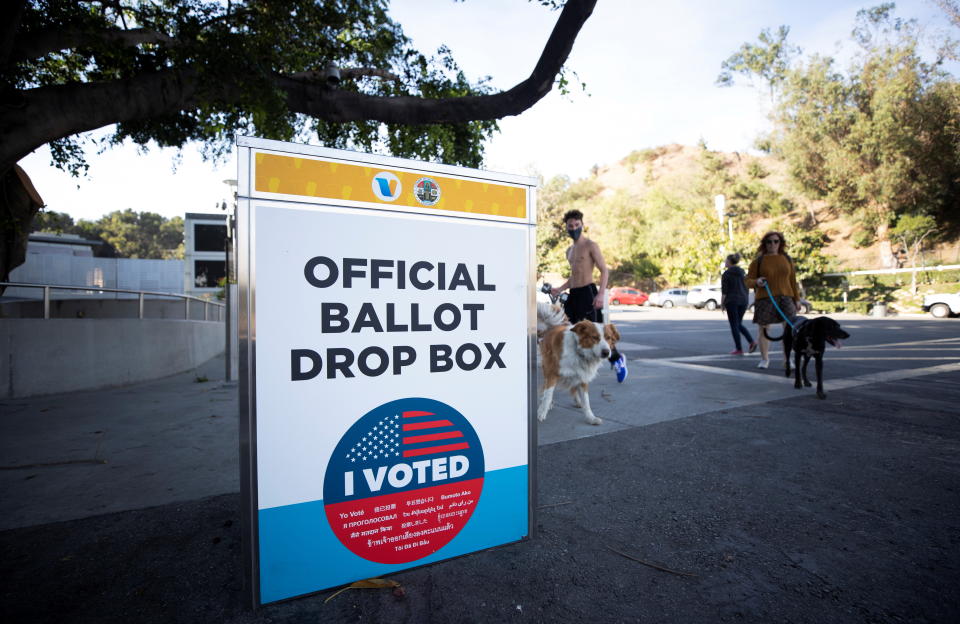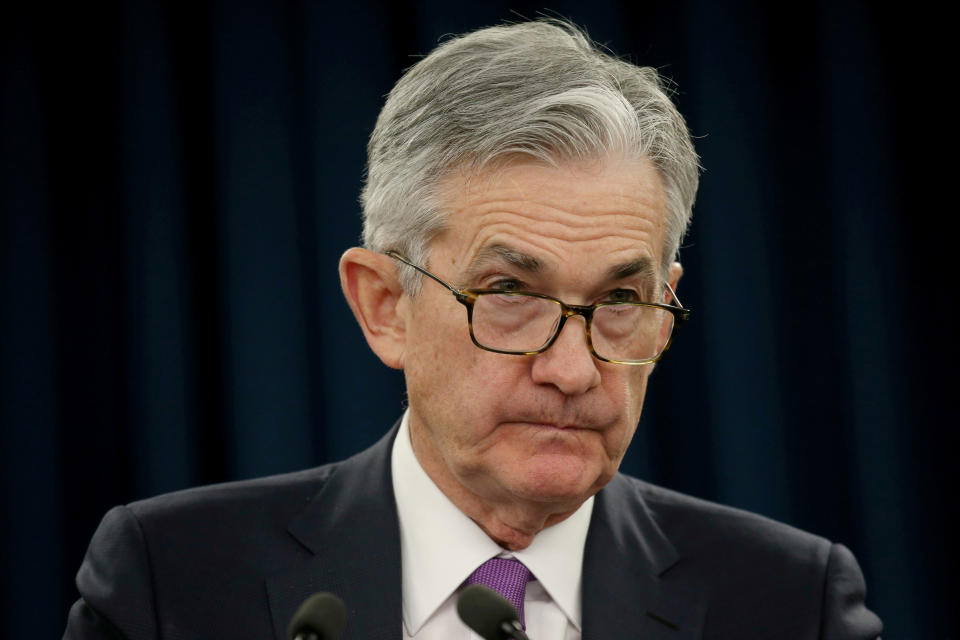Election Day, October jobs report, Fed decision: What to know in the week ahead
Traders this week will be focused primarily on gleaning results from Election Day on Tuesday, after tens of millions of Americans voted early in this year’s elections.
The October jobs report, another slew of corporate earnings reports and a meeting and monetary policy decision from the Federal Open Market Committee (FOMC) are also due out this week.
Election Day
As many investors have already acknowledged, final results over the outcome of the election may not become available quickly this year following a surge in early and mail-in voting during the coronavirus pandemic.
Uncertainty over the outcome due to delays in announcing results may drive near-term volatility in markets, as many pundits have speculated.
“This is not to say that investors should flee the markets going into the election. But this is to say that investors should prepare,” Anastasia Amoroso, JPMorgan Private head of cross-asset thematic strategy, told Yahoo Finance on Oct. 27. “The first thing, I would recommend that investors stick with their strategic allocation, because over the course of the coming weeks and months, volatility will subside, and then we’re going to revert back to the long-term fundamentals, which I would argue are improving and are somewhat positive at this point in the cycle.”
“But the second thing investors should do is consider maybe taking a little bit of gains in some of the tech shares that have done really well for them and maybe adding a little bit of hedging, because as I said, this is the most predictable potentially volatile risk that’s out there,” she added.

Beyond November, the election is set to have consequences for Corporate America as a whole, regardless of which of a number of possible outcomes transpire. A change in political party control for some combination of the White House and Senate could increase the likelihood that new legislation gets passed that alters tax rates for corporations, increases or decreases regulations for some industries, and changes the tenor of trade relations with other countries, among other factors.
And the outcome of the election will also likely influence the timing and size of an eventual fiscal stimulus package to help support the economic recovery during the ongoing pandemic.
With an eye on polls and prediction markets, Wall Street has increasingly priced in the likelihood of a “blue wave” scenario, in which former Vice President Joe Biden takes the White House and Democrats take the Senate and keep the U.S. House of Representatives. As of last Monday, UBS placed the odds of a blue wave outcome at 55%, followed at a distant second by a “status quo” outcome at a 28% chance, in which Republicans retain the presidency and Senate.
“A Democratic clean sweep is seen as far from a sure thing, however, with Biden’s predicted chances of victory well short of the 80% odds given to Hillary Clinton in 2016,” Andrew Hunter, Capital Economics senior U.S. economist, wrote in a note Friday. “That suggests there is still scope for a ‘blue wave’ to drive a rally in the stock market by raising hopes of further fiscal support.”
“But the path to another stimulus package is unlikely to be that straightforward,” he added. “The lack of a filibuster-proof majority in the Senate means the Democrats would have to choose between passing a quick stimulus bill or incorporating some of Biden’s longer-term priorities, with the resulting bill taking much longer to pass.”
“There is clearly a risk that the polls are wrong again. The most obvious alternative is that Biden wins the presidency, but the Republicans keep hold of the Senate,” Hunter added. “In that scenario, the prospects for further fiscal support would be sharply reduced. Another surprise win for President Donald Trump, which would presumably also see the Republicans win the Senate, might be greeted more positively by the markets. But with the Republicans very unlikely to win back the House, that could just see the gridlock of recent months continue.”
As of Friday, some 85 million individuals had already cast votes for the 2020 election, according to the U.S. Elections Project maintained by the University of Florida. That sum equates to well over half of the total 2016 turnout with still days to go before Election Day on Nov. 3, setting up what is expected to be the highest voter participation rate in more than 100 years.
Fed meeting
The Federal Open Market Committee (FOMC) is set to hold the first of its two-day rate-setting meeting the day after Election Day, and a monetary policy statement and press conference from Federal Reserve Chair Jerome Powell is set to follow on Thursday.
As with the past several months’ worth of meetings, the FOMC is virtually guaranteed to keep benchmark interest rates unchanged near zero, as the central bank works to continue providing support to the virus-stricken economy. In fact, after their last meeting in September, central bank officials signaled that interest rates would likely remain at their current band at least through the end of 2023.
To that end, commentary around the Fed’s assessment of current and future economic conditions during the coronavirus pandemic will be of greater interest. In the Federal Reserve’s Beige Book released in late October, the central bank underscored the “economic activity continued to increase across all Districts, with the pace of growth characterized as slight to modest in most Districts.”

FOMC members have also increasingly escalated their rhetoric calling for further fiscal stimulus to complement the monetary policy support offered by the central bank. Powell, in a public appearance in early October, noted that “too little support would lead to a weak recovery, creating unnecessary hardship for households and businesses.”
Powell on Thursday is also likely to be queried again on the Federal Reserve’s assessment of inflationary pressures, after central bank officials suggested in September that they would “aim to achieve inflation moderately above 2% for some time so that inflation averages 2% over time.” Core personal consumption expenditures, which exclude volatile food and energy prices and serve as the Fed’s preferred inflation gauge, rose just 1.5% in September over last year, remaining well below target yet again during the pandemic.
The Federal Reserve’s upcoming meeting also comes following the Fed’s announcement last Friday that it would be lowering the minimum loan size for its Main Street Lending Program, in a bid to encourage more businesses to take advantage of the pandemic-era support facility. Uptake for the Main Street Lending Program had been weak prior to that, with the Fed having offered just 400 loans totaling $3.7 billion as of Friday, out of a total $600 billion capacity. As many pundits have pointed out, many small- and mid-sized businesses have stayed on the sidelines from taking on more loans that they would eventually need to pay back during the pandemic.
October jobs report
The Department of Labor’s October jobs report due out Friday is set to be yet another piece of economic data underscoring the slowing economic recovery amid the ongoing pandemic.
Non-farm payrolls are expected to have risen by 600,000 in October, according to Bloomberg consensus data as of Friday. While this would be the sixth straight month of net payroll gains, it would also be the fourth straight month of decelerations in jobs added back to the economy. In September, non-farm payrolls had risen by 661,000.
The unemployment rate is also expected to tick lower in October, albeit at a slowing rate. The jobless rate will likely come in at 7.6%, according to consensus economists, from 7.9% in September. At the height of the pandemic in April, the unemployment rate had spiked to 14.7%.
As with the previous months’ worth of reports, the change in the number of individuals categorized as “permanent job losers” will be closely watched as a gauge of the longer-term impacts of virus-related shutdowns. In September, permanent job losers increased by 345,000 to 3.8 million, with this sum representing a leap of 2.5 million from February’s pre-pandemic level.
Data from the Labor Department’s more timely weekly unemployment claims reports has also underscored the worrying trend toward longer-term unemployment for many Americans. Based on last week’s report, another more than 387,000 individuals exhausted continuing unemployment benefits and rolled into the federal Pandemic Emergency Unemployment Compensation program. This number has continued to creep higher over the past several weeks’ worth of reports, even as headline new jobless claims have trended lower.
Earnings calendar
Monday: Clorox (CLX), Marathon Petroleum (MPC), Wingstop (WING), Estee Lauder (EL) before market open; Diamondback Energy (FANG), Paypal (PYPL), Skyworks Solutions (SWSK), AMC Entertainment Holdings (AMC), Mondelez (MDLZ) after market close
Tuesday: Wayfair (W), McKesson (MCK), Exelon (EXC), Humana (HUM) before market open; Prudential Financial (PRU), Vornado Realty Trust (VNO) after market close
Wednesday: Hilton (HLT), Sinclair Broadcast Group (SBGI) before market open; Qualcomm (QCOM), Upwork (UPWK), Fitbit (FIT), Apache (APA), GoDaddy (GDDY), Qorvo (QRVO), Allstate (ALL), Match Group (MTCH), Expedia (EXPE) after market close
Thursday: Bristol-Myers Squibb (BMY), Mylan (MYL), Regeneron (REGN), Dominion Energy (D), Hanesbrands (HBI), New York Times (NYT), SeaWorld Entertainment (SEAS), Papa John’s International (PZZA), Yeti Holdings (YETI), Cinemark Holdings (CNK), Cigna (CI), Discovery (DISCA), Duke Energy (DUK), General Motors (GM), Virgin Galactic Holdings (SPCE) before market open; Take-Two Interactive Software (TTWO), Uber Technologies (UBER), Square (SQ), Roku (ROKU), American International Group (AIG), DropBox (DBX), GoPro (GPRO), InterActive Corp (IAC), Caesars Entertainment (CZR), Zillow Group (ZG), Planet Fitness (PLNT), Electronic Arts (EA), Whiting Petroleum (WLL), Peloton (PTON), Booking Holdings (BKNG), T-Mobile (TMUS) after market close
Friday: Viacom (VIAC), Coty (COTY), CVS Health Corp (CVS), Marriott International (MAR) before market open
Economic calendar
Monday: Markit US Manufacturing PMI, October final (53.3 expected, 53.3 in prior print); ISM Manufacturing, October (55.6 expected, 55.4 in September); Construction Spending month-over-month, September (0.9% expected, 1.4% in August)
Tuesday: Factory Orders, September (0.8% expected, 0.7% in August); Durable Goods Orders, September final (1.9% in prior print); Durable Goods Orders Excluding Transportation, September final (0.8% in prior print); Non-Defense Capital Goods Orders Excluding Aircraft, September final (1.0% in prior print); Non-Defense Capital Goods Shipments Excluding Aircraft, September final (0.3% in prior print)
Wednesday: MBA Mortgage Applications, week ended Oct. 30 (1.7% during prior week); ADP Employment Change, October (688,000 expected, 749,000 in September); Trade Balance, September (-$64.3 billion expected, -$67.1 billion during prior week); Markit US Services PMI, October final (56.0 expected, 56.0 in prior print); Markit US Composite PMI, October final (55.5 in prior print); ISM Services Index, October (57.5 expected, 57.8 in September);
Thursday: Challenger Job Cuts year-over-year, October (185.9% in September); Initial Jobless Claims, week ended Oct. 31 (746,000 expected, 751,000 during prior week); Continuing Claims, week ended Oct. 24 (7.756 million during prior week); Non-farm Productivity, 3Q preliminary (3.5% expected, 10.1% during 2Q); Unit Labor Costs, 3Q preliminary (-10.0% expected, 9.0% during 2Q); FOMC Rate Decision
Friday: Change in Non-farm Payrolls, October (600,000 expected, 661,000 in September); Unemployment Rate, October (7.7% expected, 7.9% in September); Average Hourly Earnings month-over-month, October (0.2% expected, 0.1% in September); Average Hourly Earnings year-over-year, September (4.6% expected, 4.7% in September); Labor Force Participation Rate, October (61.5% expected, 61.4% in September); Wholesale Inventories month-over-month, September final (-0.1% in prior print)
—
Emily McCormick is a reporter for Yahoo Finance. Follow her on Twitter: @emily_mcck
Read more from Emily:
Tesla blows away estimates as deliveries ramp up, targets 500K deliveries by year’s end
Some wellness products growing ‘over 1,000%’ during pandemic: Ro CEO
Find live stock market quotes and the latest business and finance news
For tutorials and information on investing and trading stocks, check out Cashay
Follow Yahoo Finance on Twitter, Facebook, Instagram, Flipboard, LinkedIn, and reddit.


